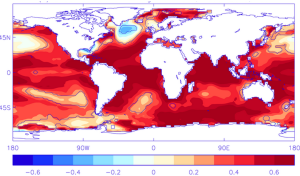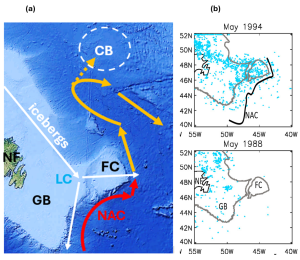
The possible role of icebergs in the origin of the North Atlantic Cold Blob
– By David Allan and Richard Allan –
Many people with an interest in ocean science will have come across the Cold Blob or ‘warming hole’, a region between the main North Atlantic currents which has cooled over a century-scale period when most of the world has warmed (Figure 1). This peculiar cold anomaly has been associated with a possible disturbance of the crucial Atlantic Meridional Overturning Circulation (AMOC) which normally cycles warm water northwards in the North Atlantic Current (NAC) in exchange for cold water passing southwards in the Labrador Current close to the east coast of Canada. Here we summarise our recent paper (Ref 3) which proposes a possible mechanism for the generation of the Cold Blob and tries to assess its potential significance in the control of AMOC and the progress of climate change.

Our work (Ref 2,3) shows that the Cold Blob intensity was largely determined by three particularly cold periods around 1972-74, 1984-85 and 1991- 94 which have never been repeated on such a scale subsequently. Without these cold episodes in the late 20th century there would have been no significant Cold Blob for anyone to talk about. If the existence of the Cold Blob mainly depends on cold events which happened 30-50 years ago, it is difficult to argue that it has any association the strength of AMOC in 2025. The Cold Blob observed over the past century is mainly a ghost of our climatological past with questionable links to present day events.
Nevertheless, it is still of interest to establish the reasons for the three cold periods at the end of the 20th century which gave rise to the Cold Blob and our work suggests that these could be related to three periods when unusually large numbers of icebergs moved down the east coast of Canada and went much further east than usual into the North Atlantic.
Every year, icebergs and associated sea ice form in the Arctic, progress down the Labrador coast of Canada in winter and ultimately melt in the spring and summer as they encounter warmer waters associated with the Gulf Stream and its extension, the North Atlantic Current (NAC). The number of icebergs varies greatly from year to year and our work has concentrated on a series of three particularly cold periods near the end of the 20th century when iceberg numbers were particularly high and they reached much further east than normal before melting.
1973, 1985 and 1994 were especially cold years when icebergs reached as far as the Flemish Cap (FC in Figure 2) a peculiar sub-surface island of the Canadian continental shelf 500km off the coast of Newfoundland (NF) where the water is sufficiently shallow to ground and ensnare the largest icebergs, with a draft of more than 100m. On the other hand, in comparatively warm years like 1980 or 1988, icebergs and sea ice scarcely even reached the coast of Newfoundland before melting. The Flemish Cap is of particular significance because the NAC carrying warm salty water northwards passes just east of the Flemish Cap while the cold Labrador Current (LC) carrying icebergs and sea ice passes just west on its way south close to the Grand Banks (GB, Figure 2a). The Flemish Cap is thus a critical junction between the two most important ocean currents in the northern North Atlantic.
Not surprisingly, in those years (e.g. 1994, Figure 2b), when icebergs reached the Flemish Cap, sea surface temperatures there fell close to freezing, lower than in any other years between 1930 and 2020. We noticed that in those cold years, some icebergs went even further east than the Flemish Cap and into the region where the NAC carried warm waters northwards. (Figure 2a,b). It would be most unusual to find icebergs in the warm salty NAC and we wondered if the very cold water produced by the melting of these icebergs and sea ice might be carried north in the NAC and give rise to the Cold Blob.
We found that temperatures in the region of the Cold Blob (Figure 2) fluctuated in step with annual changes in temperature at the Flemish Cap (Ref 3). This finding would be consistent with the hypothesis that the NAC was cooled by unusual numbers of icebergs travelling far east and that their cold influence was transferred northwards to the region of the Cold Blob. It is not a simple matter to identify currents which might leave the NAC and form a cool pool that becomes the Cold Blob and in our current work we would like to investigate this further.

(a) The path of icebergs in the Labrador Current (LC) across the Flemish Cap (FC) and past the Grand Banks (GB). NAC is the North Atlantic Current and CB is the epicentre of the Cold Blob. Water less than 400m deep is shown as pale blue and water more than 4000m deep is dark blue. NF is part of Newfoundland, including St Johns.
(b) Icebergs reach the Flemish Cap and the NAC (black line) in May 1994 (high iceberg year) but not in 1988 (low iceberg year)
Our wider perspective sees the connection of the high ice and iceberg years in the later 20th century to dramatic releases of thick ice from the Arctic Sea in that period. Enhanced release of ice and icebergs from the Arctic might be expected with continued global warming so there is the possibility in the future that we might again see increased numbers of icebergs crossing the Flemish Cap, joining the NAC and renewing the Cold Blob. Eastern Canada will have a ringside seat in this drama.
David Allan is a former Reader in the Department of Physiology, University College London UK who has developed a late interest in North Atlantic currents.
Richard Allan is Professor of Climate Science in the Department of Meteorology, University of Reading, UK. His interests are primarily in atmospheric science. He was a Lead Author on the 6th Assessment Report of the Intergovernmental Panel on Climate Change (2023).
References
- Allan, D. and Allan, R. P. (2019) Seasonal changes in the North Atlantic cold anomaly: The influence of cold surface waters from coastal Greenland and warming trends associated with variations in subarctic sea ice cover. J. Geophys. Res. Oceans, 124, 9040-9052. https://doi.org/10.1029 /2019JC015379.
- Allan, D. and Allan, R.P. (2024) Odden ice melt linked to Labrador Sea ice expansions and the Great Salinity Anomalies of 1970-1995 Geophys. Res. Oceans, 129, e2023JC019988. https://doi.org/10.1029/2023JC019988.
- Allan, D. and Allan R.P. (2025) Influence of Meltwater from Labrador Sea ice and icebergs transported via Flemish Cap on the long-term North Atlantic Cold Anomaly. Atmosphere -Ocean https://doi.org/10.1080/07055900.2025.2478832.
Arctic sea, cold blob, david allan, richard allan, warming hole
